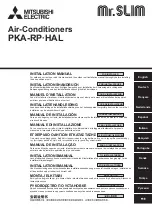
15
7.2.2. Using wireless remote controller (Fig. 7-5)
1
Turn on the power to the unit at least 12 hours before the test run.
2
Press the
TEST RUN
button twice continuously.
(Start this operation from the status of remote controller display turned off.)
A
TEST RUN
and current operation mode are displayed.
3
Press the
MODE
button to activate
COOL
mode, then check whether
cool air is blown out from the unit.
4
Press the
MODE
button to activate
HEAT
mode, then check whether
warm air is blown out from the unit.
5
Press the
FAN
button and check whether fan speed changes.
6
Press the
VANE
button and check whether the auto vane operates properly.
7
Press the ON/OFF button to stop the test run.
Note:
•
Point the remote controller towards the indoor unit receiver while
following steps
2
to
7
.
• It is not possible to run the in FAN, DRY or AUTO mode.
7.2.3. Using SW4 in outdoor unit
Refer to the outdoor unit installation manual.
7.3. Self-check
7.3.1. Wired remote controller
■
Refer to the installation manual that comes with each remote controller for details.
7.3.2. Wireless remote controller (Fig. 7-6)
1
Turn on the power.
2
Press the
CHECK
button twice.
(Start this operation from the status of remote controller display turned off.)
A
CHECK
begins to light.
B
“00” begins to blink.
3
While pointing the remote controller toward the unit’s receiver, press the
h
button. The check code will be indicated by the number of times that the buzzer
sounds from the receiver section and the number of blinks of the operation lamp.
4
Press the ON/OFF button to stop the self-check.
ON/OFF
TEMP
FAN
VANE
TEST RUN
AUTO STOP
AUTO START
h
min
LOUVER
MODE
CHECK
RESET
SET
CLOCK
TEST RUN
5
7
A
3
,
4
2
6
Fig. 7-5
ON/OFF
TEMP
FAN
VANE
TEST RUN
AUTO STOP
AUTO START
h
min
LOUVER
MODE
CHECK
RESET
SET
CLOCK
CHECK
2
4
A
3
B
Fig. 7-6
7. Test run
Step 5 Stop the test run.
1
Press the [ON/OFF] button to stop the test run. (The Test run menu will appear.)
Note: If an error is displayed on the remote controller, see the table below.
LCD
Description of malfunction
LCD
Description of malfunction
LCD
Description of malfunction
P1
Intake sensor error
P9
Pipe sensor error (dual-wall pipe)
E0 ~ E5
Communication error between the
remote controller and the indoor unit
P2
Pipe sensor error (liquid pipe)
PA
Leakage error (refrigerant system)
P4
Drain
fl
oat switch connector disconnected
(CN4F)
PL
Refrigerant circuit abnormal
P5
Drain over
fl
ow protection operation
FB
Indoor controller board error
E6 ~ EF
Communication error between the
indoor unit and the outdoor unit
P6
Freezing/overheating protection
operation
U*, F*
(* indicates an
alphanumeric
character
excluding FB.)
Outdoor unit malfunction
Refer to the wiring diagram for the
outdoor unit.
P8
Pipe temperature error
See the table below for the details of the LED display (LED 1, 2, and 3) on the indoor controller board.
LED1 (microcomputer power supply)
Indicates whether control power is supplied. Make sure that this LED is always lit.
LED2 (remote controller power supply)
Indicates whether power is supplied to the wired remote controller. The LED is lit only for the indoor unit that is con-
nected to the outdoor unit that has an address of 0.
LED3 (indoor/outdoor unit communication)
Indicates whether the indoor and outdoor units are communicating. Make sure that this LED is always blinking.
Summary of Contents for PKA-RP HAL
Page 223: ......
















































